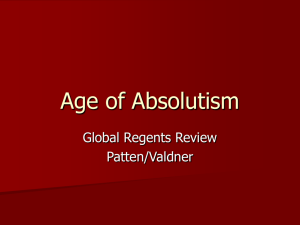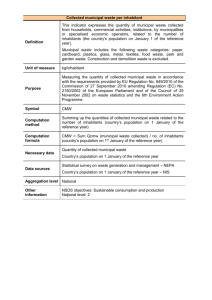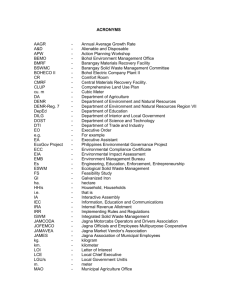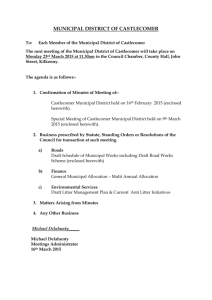Financing City Infrastructure - South African Cities Network
advertisement
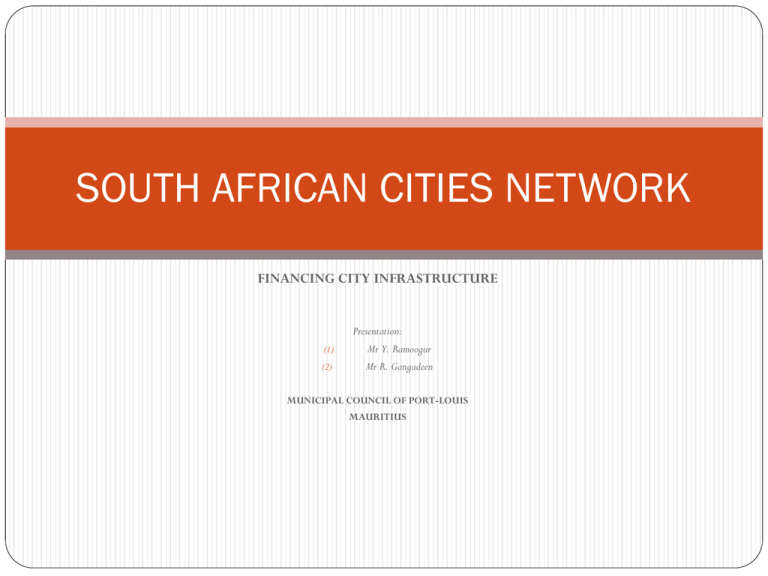
SOUTH AFRICAN CITIES NETWORK FINANCING CITY INFRASTRUCTURE (1) (2) Presentation: Mr Y. Ramoogur Mr R. Gangadeen MUNICIPAL COUNCIL OF PORT-LOUIS MAURITIUS Republic of Mauritius A small island in Indian Ocean Formerly it was a British colony Independent since 1968 Acceded to status of republic in 1992 A democratic island state Population - around 1.2 million Official language: English Spoken language:French,Creole, other oriental languages Local Government in Mauritius Governed by Local Government Act 1989 and Local Govt Act 2003 partly proclaimed Municipal and District Council elections are held every 5 years Ministry of Local Government which monitors and controls Local Authorities in Mauritius Local authorities are autonomous and Ministry acting as a facilitator Decentralised services provided by local authorities Local Authorities MUNICIPAL COUNCILS 5 municipal councils for urban areas -Municipal Council of Port Louis - Municipal Council of Beau Bassin/Rose Hill -Municipal Council of Curepipe - Municipal Council of Quatre Bornes - Municipal Council of Vacoas/ Phoenix 24 elected Councillors for each Municipal Council except Port Louis having 30 Councillors District Councils 4 District Councils in Mauritius , especially rural areas Pamplemousses /Riviere du Rempart District Council Moka/Flacq District Council Grand Port/Savanne District Council Black River District Council 36 elected Councillors for each D.C. Municipal Council of Port Louis Port Louis is the capital city of Mauritius Only port in Mauritius Strategic position in the Indian Ocean Many sea routes pass through Port Louis Major economic activities (banking,shipping,Central Bank) take place in Port Louis It is also a historical, commercial and touristic city National Assembly , Prime Minister’s Office and most of the Ministries are found in Port Louis Meetings and proceedings All decisions are taken at committee level Standing Committees (quorum 5 members) Finance committee Works Committee Public Health Committee Welfare Committee Committee of the Whole Council ( quorum 13 members ) Four Quarterly council meetings also held every year Council may set up other committees to dispense its business Permits and Business Monitoring Committee set up by the Business Facilitation Act 2006 Port Louis and its Population 1990 population was 133,073 2000 population dropped to 127,855 2011 Estimated population- around 128,000 Fall in population since 1990 explained by lack of space with no possibility of expansion Rapid development of habitations outside the boundaries of Port Louis City centre – mainly used as commercial, economic and touristic activities A city of different cultures Port Louis, a metropolitan city Daily roving population and visitors – more than 100,000 . Various governmental services are offered in Port Louis Port Louis obliged to meet people’s demand in addition to its existing population Port Louis and Municipal Infrastructures Central Market Other markets and fairs A city for sports- ( volley ball, basket ball, handball, etc ...) Social and Community and day care centres Football grounds with lighting facilities and seating accommodation swimming pools Departments of the Council Chief Executive Department Welfare Works Health and Environment Planning Financial Controller’s Library Parks and Gardens Duties and responsibilities of the council To provide good living and working environment Provision of key services Promote welfare of citizens Ensure social and economic progress Services offered to both inhabitants and roving population and visitors, tourists etc.. Main services offered Collection and disposal of solid waste Lighting of highways /roads and public places Construction,, maintenance and cleaning of public infrastructures such as roads, storm drains, canals, pavements, bridges, riverbeds Resurfacing of roads Provision and control of public markets and fairs as well as places of public auction Main services offered( continued) Provision, management and maintenance of social amenities such as social centres, public libraries, theatres, nurseries for infants, kindergartens , cemeteries, cremation grounds Issue of building/development permits (commercial, industrial, professional activities) Control of parking spaces Control of movement of street hawkers Control and maintenance of bus stations Organization of welfare, sports and leisures and artistic/cultural activities Any undertaking approved by the Minister of Local Government Programme-Based Budget All services are financed by recurrent budget The programme-based budget Funds are earmarked based on programmes/outcome Result oriented Resources earmarked accordingly PBB- 5 programmes Since the year 2011, the programme-based budget used and funds are provided with respect programmes. These programmes are: Programme 1: Policy and Management Programme 2: Promotion and maintenance of sound and healthy condition in the city Programme 3: Provision and maintenance of community-based infrastructure Programme 4: Promotion of sports, welfare, education and cultural activities Programme 5: Managing development within the Council’s boundaries PBB 2011 Total budget – Rs 655 million (approx. R163.5 million) Sources of income: Rs million General rates Tenant’s Tax Trade fees Market fees Other Income Grants-in-Aid Total 96 68 60 22 44 365 655 Grant in Aid Central Government finance local authorities by way of grant in aid Represents about 50% to 55 % of total recurrent revenue However as a result of recent global economic crisis , grant in aid has been reduced Government policy is to reduce further the grant in aid in the future Council to identify alternative source of finance Council’s own revenue Council’s own revenue below represents about 45% of total budget General rates Tenant’s Tax Trade fees Market fees Interest on investment Rental Bus toll Advertisement and publicity fees Other Income Financing Municipal Infrastructure Council’s capital expenditure is financed by General Fund, including Budgetary Surpluses, and capital grants from the Central Government known as the Local Infrastructure Fund. Since financial year 2009, the Central Government has granted Rs 100 million (nearly R25 million) to each local authority including the Municipal Council of Port Louis. Local Infrastructure Fund Rs’million Construction of roads and drains 30 Multipurpose complex at Residence Vallijee 11 Pont de Paris fair 11 Abercrombie Market/ Fair 19 Minor Capital Projects 10 Other upgrading works, incl. Sports grounds 19 Total 100 (Rs 100m=R25m approx.) Projects financed by LIF and Municipal Funds Reconstruction of Abercombie market/fair Local Infrasructure Fund = Rs 34 m Municipal Fund =Rs 20 m Multipurpose complex at Residence Vallijee Local Infrasructure Fund = Rs 11,462,000 Municipal Fund =Rs 331,500 Project financed by grant from Central Government and Council’s contribution Renovation of Port Louis Theatre =Rs 50 million (appr. R12.5 million) Council injected Rs 1 million ( appr. R250,000 ) Can Government provide more funds for infrastructures? If Government’s budget allows. In the past few years ,it has various projects. In case of national heritage, Central Government funds can be made available In the context of ‘save energy’ programme of the Government, street lighting using solar energy should be encouraged Other projects of public interest may attract Government financing Advantages of Government Infrastructure finance Such finances are grants which are not refundable They often represent huge amounts which allows projects to be easily realised The Municipal Council needs not contract bank loans and hence avoid interest payment When Government provides funds for targeted and priority projects , the municipal council can use its own funds to realise other additional projects Disadvantages of Government Infrastructure finance The Government can impose its priorities and conditions Government priority may probably not be Council’s priority Projects financed by budgetary surpluses Financial year 2008/09 = 15 projects realised for value Rs 23.2 million Half year ended 31 Dec 2009=6 projects realised for value Rs 9.8 million F/Y 2010 = Surplus realised Rs 35 million. More capital projects may be realised by 90% of above sum. Given the surplus realised, the municipal council can sustain borrowings to realise income generating projects Advantage of using municipal funds Council can decide its priorities. No conditions attached Projects can be realised in short delays No interest payment applies Borrowings Financing infrastructures from borrowings have often conditions attached (guaranties ) and not in the interest of the council High interest payment may apply A New Concept The Way Forward Funding through C.S.R ( Corporate Social Responsibility ) by Private Firms and Companies A big plus (+) towards financing Municipal Infrastructure -Social and Sports projects -Poverty alleviation / Economic empowerment of the poor Conclusion It is in the interest of the municipal council to get financial support from Central Goverment Central Government and municipal council partnership will always be to the advantage of the citizens Projects requiring massive investments , such as renovation of the Port Louis theatre, being a national heritage, could not have been possible without Government financial support XXXXXXXX Thank you. From Mr Rajcoomar Gangadeen, Financial Controller MrYougraj Ramoogur, Engg Assistant Municipal Council of Port Louis, Republic of Mauritius SACN 25 May 2011 Worshop on financing of city government services in Southern Africa
